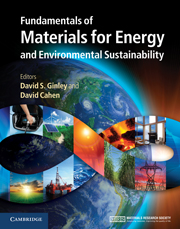Book contents
- Frontmatter
- Contents
- Contributors
- Preface
- Acknowledgments
- Part 1 Energy and the environment: the global landscape
- Part 2 Nonrenewable energy sources
- 9 Petroleum and natural gas
- 10 Advancing coal conversion technologies: materials challenges
- 11 Oil shale and tar sands
- 12 Unconventional energy sources: gas hydrates
- 13 Nuclear energy: current and future schemes
- 14 Nuclear non-proliferation
- 15 Nuclear-waste management and disposal
- 16 Material requirements for controlled nuclear fusion
- Part 3 Renewable energy sources
- Part 4 Transportation
- Part 5 Energy efficiency
- Part 6 Energy storage, high-penetration renewables, and grid stabilization
- Summary
- Appendix A Thermodynamics
- Appendix B Electrochemistry
- Appendix C Units
- Index
- References
12 - Unconventional energy sources: gas hydrates
from Part 2 - Nonrenewable energy sources
Published online by Cambridge University Press: 05 June 2012
- Frontmatter
- Contents
- Contributors
- Preface
- Acknowledgments
- Part 1 Energy and the environment: the global landscape
- Part 2 Nonrenewable energy sources
- 9 Petroleum and natural gas
- 10 Advancing coal conversion technologies: materials challenges
- 11 Oil shale and tar sands
- 12 Unconventional energy sources: gas hydrates
- 13 Nuclear energy: current and future schemes
- 14 Nuclear non-proliferation
- 15 Nuclear-waste management and disposal
- 16 Material requirements for controlled nuclear fusion
- Part 3 Renewable energy sources
- Part 4 Transportation
- Part 5 Energy efficiency
- Part 6 Energy storage, high-penetration renewables, and grid stabilization
- Summary
- Appendix A Thermodynamics
- Appendix B Electrochemistry
- Appendix C Units
- Index
- References
Summary
Focus
Gas hydrates are typically formed when water and gas (e.g., light hydrocarbons) come into contact at high pressure and low temperature. Current estimates of the amount of energy trapped in naturally occurring gas hydrate deposits, which are found in ocean sediments along the continental margins and in sediments under the permafrost, range from twice to orders of magnitude larger than conventional gas reserves. This has led to gas hydrates being considered as a potential future unconventional energy source.
Synopsis
Gas hydrates (or clathrate hydrates) are icelike crystalline solids imprisoning gas molecules (e.g., methane, carbon dioxide, hydrogen) within icy cages. These fascinating solids present an attractive medium for storing energy: naturally in the deep oceans and permafrost regions, which hold vast quantities of energy waiting to be unlocked and used as an alternative energy supply; and artificially by manipulating synthetic clathrate materials to store clean fuel (natural gas or hydrogen). Conversely, the formation of these solids in oil and gas flowlines (the pipes through which oil and gas are transported, for example, from a well to a processing facility) can lead to blockage of the flowlines and disastrous consequences if not carefully controlled. This chapter on gas hydrates begins with an overview of the discovery and evolving scientific interest in gas hydrates, followed by a basic description of the structural and physical properties of gas hydrates and the different energy applications of gas hydrates. The main focus of this chapter is on surveying the potential prospect of producing energy in the form of clean gas from naturally occurring gas hydrates, which present a potential alternative energy resource and could be a significant component of the alternative energy portfolio. The paradigm shift from exploration to production of energy from gas hydrates is clearly illustrated by the production tests that have either been performed or are planned in the Mackenzie Delta in Canada, on the North Slope of Alaska, and off the coast of Japan.
- Type
- Chapter
- Information
- Publisher: Cambridge University PressPrint publication year: 2011



